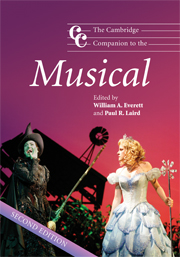Book contents
- Frontmatter
- Part I Adaptations and transformations: before 1940
- Part II Maturations and formulations: 1940–1970
- Part III Evolutions and integrations: after 1970
- Part IV Legacies and transformations
- 17 Why do they start to sing and dance all of a sudden? Examining the film musical
- 18 Revisiting classic musicals: revivals, films, television and recordings
- 19 The creation of a Broadway musical: Stephen Schwartz, Winnie Holzman, and Wicked
- Notes
- Select bibliography
- Index
17 - Why do they start to sing and dance all of a sudden? Examining the film musical
from Part IV - Legacies and transformations
Published online by Cambridge University Press: 28 September 2011
- Frontmatter
- Part I Adaptations and transformations: before 1940
- Part II Maturations and formulations: 1940–1970
- Part III Evolutions and integrations: after 1970
- Part IV Legacies and transformations
- 17 Why do they start to sing and dance all of a sudden? Examining the film musical
- 18 Revisiting classic musicals: revivals, films, television and recordings
- 19 The creation of a Broadway musical: Stephen Schwartz, Winnie Holzman, and Wicked
- Notes
- Select bibliography
- Index
Summary
Prologue
At a crucial moment in Hedwig and the Angry Inch (2001), our hero(ine), Hedwig, is abandoned by Sgt Luther Robinson and left to fend for him/herself in an isolated trailer park in Junction City, Kansas – a long, long way from his/her East Berlin home. Images of the Berlin Wall being torn down play on the TV and a few piano chords are heard off-screen as the TV reporter comments: ‘The Germans are a patient people and good things come to those who wait.’ With this indirect reminder of what might have been had Hedwig stayed at home, the camera pans from an anniversary present (a ‘Wig in a Box’) across the interior of the trailer and we catch a glimpse through the window of a lone immigrant musician outside playing a toy-like keyboard slung around his neck before Hedwig is revealed lying disconsolately on the couch. Though all appears to be lost, Hedwig begins to sing about the healing power of performance. The second verse adds guitar and drums to the accompaniment and the camera again pans to the window to reveal a guitarist outside. After the second chorus, a band of itinerant, Eastern European immigrant musicians (whom Hedwig will later call the ‘ambassadors of Eastern Bloc Rock’) file joyously through the door of the trailer brandishing guitars (though none is plugged in) and an impossibly small portable drum set and continue accompanying this song of recovery and rejuvenation.
- Type
- Chapter
- Information
- The Cambridge Companion to the Musical , pp. 303 - 324Publisher: Cambridge University PressPrint publication year: 2008



